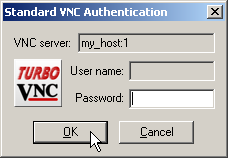

First we describe the options that control TurboVNC’s compression of images in TABLE B-3.

TurboVNC allows user control to balance the (often conflicting) goals of high image quality and high performance. TurboVNC Image Encoding Protocols and Dynamic Quality/Performance Tradeoff
#TURBO VNC FOR MAC MAC OS#
Use Low Quality connection profile (on UNIX or Mac OS X).Ĭonnect to the VNC server session running on machine host and listening on port port. Minimize bandwidth consumption at the expense of image quality. Use Medium Quality connection profile (on UNIX or Mac OS X). Improve performance, at the expense of image quality. See Chrominance Subsampling for more information. Once connected, you can change this setting dynamically using the F8 menu. Where s is 1x for no subsampling (4:4:4), 2x for 4:2:2 subsampling, 4x for 4:2:0 subsampling, or gray for no chominance. Set the JPEG chrominance subsampling to s. Once connected, you can change this dynamically using the F8 menu. Where q is a number between 1 and 100 (default is 95).
#TURBO VNC FOR MAC PASSWORD#
The default is to allow any user who correctly enters your VNC password to view your session. Similar to previous scenario, but do not allow others to view or share your session. Note the single colon, as is standard for an X display name. TABLE B-2 Common TurboVNC Viewer ScenariosĬonnect to the VNC server session running on machine host that has an X display number of display.

#TURBO VNC FOR MAC WINDOWS#
Options that would be used on UNIX and on Windows are provided. TABLE B-2 describes different scenarios for starting a TurboVNC viewer from a command line. These are further described in TurboVNC Image Encoding Protocols and Dynamic Quality/Performance Tradeoff A small GUI (shown in TurboVNC Connection Dialog on a Windows Client) appears to allow selection of image encoding protocol and related parameters. On a Windows host, start a TurboVNC viewer by selecting TurboVNC Viewer in the TurboVNC Start Menu group. The xstartup file that TurboVNC creates uses operating system specific techniques to launch the user’s most recently used window manager. This startup file is named $HOME/.vnc/xstartup.turbovnc on release 1.1.1 and $HOME/.vnc/xstartup on previous releases. If the file does not exist, the TurboVNC session creates one. Upon startup, the TurboVNC server session uses the user’s VNC startup file. TurboVNC sessions can only be killed by the user that started the session. Kill the TurboVNC session of X display number display. Lists all the TurboVNC sessions of the current user on this host. Where the desktop is w x h pixels in size. Start a TurboVNC session with a given virtual desktop size. The X display number of a TurboVNC session is printed out whenever you start the session. Start a TurboVNC session with default settings. TABLE B-1 Common TurboVNC Server Scenarios TABLE B-1 describes different scenarios for the TurboVNC server, the vncserver command, and respective comments. Common TurboVNC Scenarios TurboVNC Server Scenarios


 0 kommentar(er)
0 kommentar(er)
